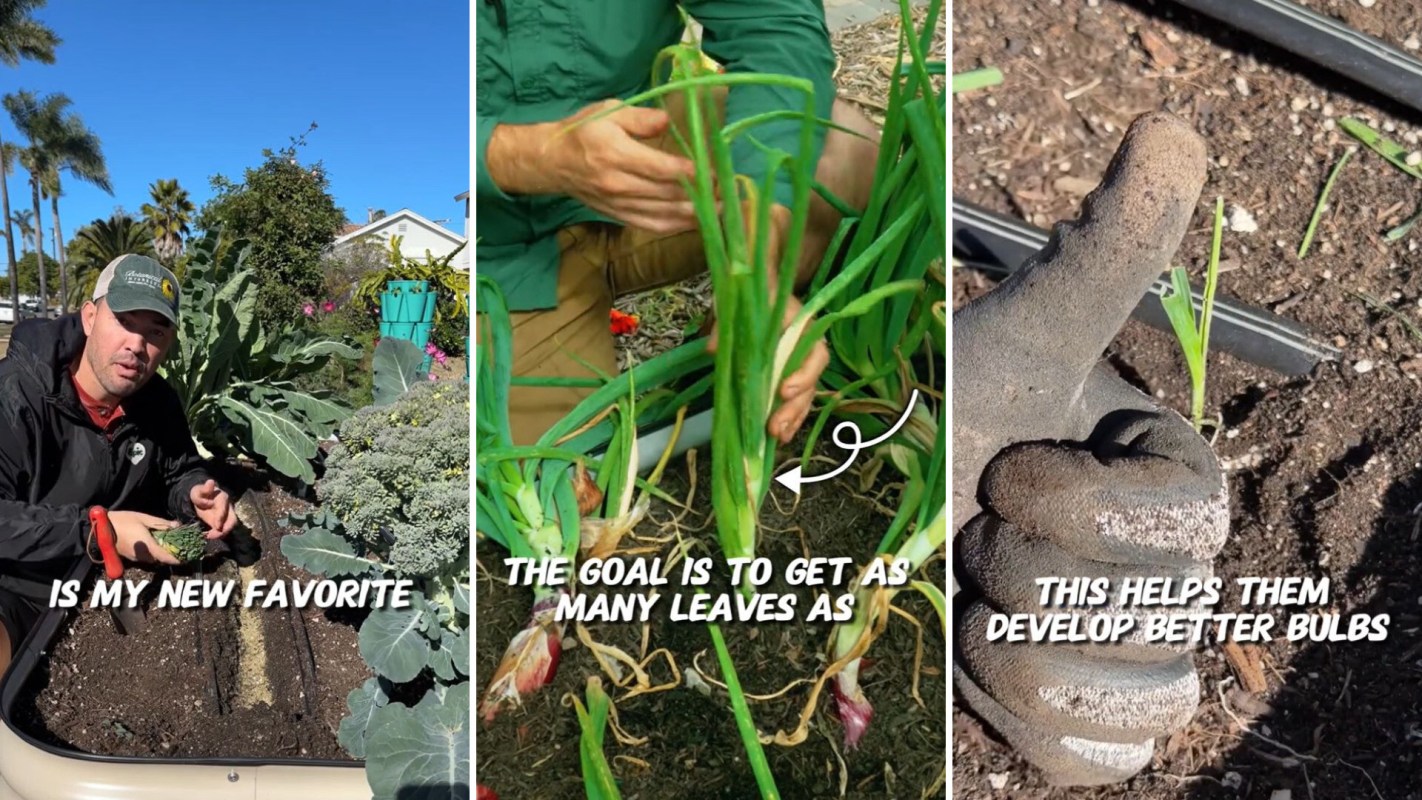As a natural pest repellent, onions are a great addition to any garden. One TikToker revealed a tried-and-true way to grow the very best and biggest onions around.
The scoop
On a mission to teach the world how to grow their own food, Epic Gardening (@epicgardening) shared their method to produce monster onions.
@epicgardening MONSTER ONIONS - Last year, I grew the biggest onions of my life - and I'll beat that this year with this trick! Start by getting your tools: onion starts, a trowel, gloves, and a slow-release organic fertilizer that's high in nitrogen and phosphorus (the NP of NPK). The phosphorus promotes healthy bulb development while the nitrogen produces leaves. Each leaf stalk adds one layer to the eventual bulb! Measure 8" from the side of your raised bed, then make a 4" wide trench, with another 8" of space for onions on the other side of the trench. Add fertilizer to the trench between onion rows, then cover with soil. Then, lay your onions out on either side of the trench, spaced about 6" apart. Plant them 1" deep, 3" from the side of the trench, and 6" apart - this gives room for your future giant bulbs to grow. Don't plant any deeper than 1" as it can slow bulb development. Keep the soil damp to the touch, fertilize only the trench between the onions if you decide to add more fertilizer, and enjoy some truly massive onions when it's time to harvest! P.S. This works with many allium crops (leeks, onions, shallots, garlic, etc.) If you're looking for great recommendations, I love 'Yellow Granex PRR' (Yellow), 'Flat of Italy' (Red), and 'Gladstone' (White). Keep in mind you need to consider what onion type works for you (short-day or long-day). All available shipped ASAP to your garden from our seed company @Botanical Interests ♬ original sound - Epic Gardening
The video is a generous step-by-step how-to with a detailed explanation in the post. First, you need onion starts, gloves, a trowel, and organic fertilizer.
Dig a trench with enough room on both sides to plant onions. Epic Gardening suggests a four-inch wide trench with eight inches on either side.
Fill the trench with a slow-release organic fertilizer that's high in nitrogen and phosphorous — the NP of NPK on fertilizer bags.
"The phosphorus promotes healthy bulb development while the nitrogen produces leaves," explains Epic Gardening.
The goal is to get as many leaves as possible before your onions start to bulb because each leaf adds another layer to the onion.
Cover up the trench with soil and lay your onions six inches apart along each side of the trench so they have plenty of room to grow. Plant them about an inch deep to help develop better bulbs.
"Last year I grew the biggest onions of my life," Epic Gardening proclaims. "And that's why this is my new favorite way of planting onions."
If you're unsure which onion variety to grow, the caption even goes so far as to recommend specific types of seeds from Botanical Interests, including Yellow Granex PRR (yellow), Flat of Italy (red), and Gladstone (white).
How it's helping
The Lancet Planetary Health reported that those who garden are healthier than those who don't due to increased physical exercise and overall fiber intake. It's also an opportunity to plan, design, learn, create, and experiment.
If you've been to a grocery store lately, you know growing your own food also saves money. According to the U.S. Bureau of Labor Statistics, grocery prices have risen 2.7% in the last year, and that's coming off of already increased prices from the previous years.
Agriculture is responsible for 11% of the world's carbon pollution, according to the Center for Climate and Energy Solutions. Gardening reduces agricultural impact on the environment by decreasing the demand for mass-produced, store-bought, and globally shipped produce since food isn't being transported or packaged.
Fewer personal trips to the store save time and energy while decreasing air pollution by canceling out extra car trips.
Farm-to-table is the way to go. Whether you have a lot of space, no space, live in a tiny apartment, or have access to a community garden, there are plenty of gardening solutions for every living situation.
What everyone's saying
With the post garnering over 45,000 likes, it's safe to say users appreciated the wisdom.
"Great tip!" one commented.
"This was extremely helpful," wrote another.
"Am I the only one who didn't realize green onions grow into regular onions?" a third asked.
"Keep up the great content," praised one more.
Join our free newsletter for easy tips to save more, waste less, and help yourself while helping the planet.









